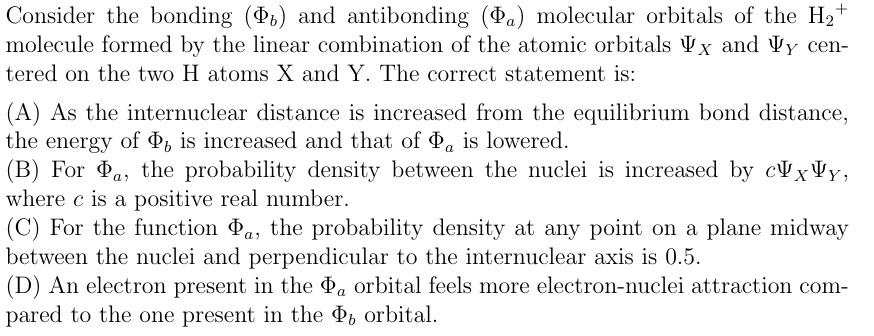Question
Question: Consider the bonding ($\Phi_b$) and antibonding ($\Phi_a$) molecular orbitals of the $H_2^+$ molecul...
Consider the bonding (Φb) and antibonding (Φa) molecular orbitals of the H2+ molecule formed by the linear combination of the atomic orbitals ΨX and ΨY centered on the two H atoms X and Y. The correct statement is:

As the internuclear distance is increased from the equilibrium bond distance, the energy of Φb is increased and that of Φa is lowered.
For Φa, the probability density between the nuclei is increased by cΨXΨY, where c is a positive real number.
For the function Φa, the probability density at any point on a plane midway between the nuclei and perpendicular to the internuclear axis is 0.5.
An electron present in the Φa orbital feels more electron-nuclei attraction compared to the one present in the Φb orbital.
As the internuclear distance is increased from the equilibrium bond distance, the energy of Φb is increased and that of Φa is lowered.
Solution
The H2+ molecule is formed from the linear combination of two 1s atomic orbitals, ΨX and ΨY, centered on atoms X and Y. The bonding (Φb) and antibonding (Φa) molecular orbitals are given by:
Φb=Nb(ΨX+ΨY) (bonding molecular orbital, σ1s)
Φa=Na(ΨX−ΨY) (antibonding molecular orbital, σ1s∗)
where Nb and Na are normalization constants.
- Energy of Φb: The potential energy curve for a bonding molecular orbital (Φb) has a minimum at the equilibrium bond distance. If the internuclear distance is increased from this equilibrium distance, the bond weakens, and the energy of the system increases, approaching the energy of the separated atoms. So, the energy of Φb is increased.
- Energy of Φa: The potential energy curve for an antibonding molecular orbital (Φa) is purely repulsive. Its energy is always higher than that of the separated atomic orbitals. As the internuclear distance increases, the repulsive interactions decrease. Consequently, the energy of Φa continuously decreases, approaching the energy of the separated atomic orbitals from above. So, the energy of Φa is lowered.
Therefore, statement (A) is correct.
